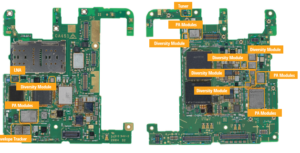
5G conundrum awaits smartphone OEMs
EP&T Magazine
Electronics Test & Measurement Wireless Engineering 5G smartphones test wirelessRecent 5G smartphone teardowns show that RF front-end content, complexity has created challenges for phone makers
Global tech market advisory firm, ABI Research, using the teardown expertise of System Plus Consulting, unpacked nine leading second-generation 5G smartphones to discover that RF Front End (RFFE) content is evidently moving to full level integrated modem-RF system designs, which will be the key to success as the market advances to wider 5G adoption.

Sharp Aquos R5G Qualcomm RFFE Content
“The 5G smartphone market is set to rapidly expand in the next 12-months, with many mobile vendors looking to quickly develop their 5G portfolios. However, a host of extremely complex challenges lie ahead for smartphone vendors, which they must overcome to fully realize the 5G demand explosion across all tiers,” says David McQueen, research director at ABI Research.
5G cellular system design
The move to 5G requires an integration of the entire 5G cellular system design into OEMs’ devices, from modem-to-antenna, addressing all aspects of end-to-end performance. This complexity level includes the integration and deployment of new 5G modem and RFFE components, features, and functionalities, leading to substantial changes in the design of mobile devices.
“Smartphone OEMs are finding this change particularly challenging, as it makes their RFFE component procurement process and system design far more complex than ever,” explains McQueen. “Unless adequately addressed, the burden brought about by the complexities of implementing 5G can lead to several issues, including lengthy product development cycles, more expensive devices, and huge constraints on device industrial designs.”
Modem-RF system procurement
OEMs will have to rationalize the delegation of modem-RF system procurement to a handful of suppliers and, most importantly, make sure they pick the right partner. “Notably, it needs to be one with a well-proven, tested, or validated rich RFFE portfolio and a comprehensive 5G roadmap. The delegation brings several advantages, many of which have become increasingly stark as the device market transitions to 5G,” McQueen asserts.

Main pcb for Sharp Aquos R5G. Sources: System Plus Consulting, ABI Research, June 2020
The teardowns show there are already signs that several OEMs are moving away from RF component assembly and adopting 5G design from modem-to-antenna.
“Such a strategic approach has been carried out by few component suppliers in the market, thus far. Qualcomm is currently the only one able to offer an end-to-end product portfolio from modem-to-antenna, supplying products with end-to-end performance in fully integrated system designs,” says McQueen. “Third-party modem-RF system design will become a mainstream approach in support of many of the world’s top smartphone OEMs to solve their 5G conundrum, also influencing decision-making across all technologies, so Qualcomm is likely to be joined by others IF they can offer such turnkey solutions.”
These findings are from ABI Research’s 5G Teardowns Reveal Qualcomm’s RF Leadership Due to Growing Design Complexity whitepaper.
